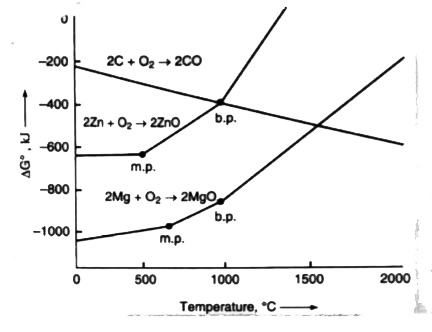During roasting the temperature should be kept below its m.p. Why ?
Step-by-Step Solution:
1. Understanding Roasting: Roasting is a metallurgical process where sulfide ores are heated in the presence of excess oxygen. This process converts the sulfide ores into oxides, which are typically more amenable to further processing.
2. Temperature Control: During roasting, it is crucial to maintain the temperature below the melting point of the ore. This is because if the temperature exceeds the melting point, the ore will melt.
3. Consequences of High Temperature: If the temperature is raised above the melting point, the molten ore can mix with volatile impurities present in the material. This mixing can lead to the formation of unwanted compounds or phases that can complicate the extraction process.
4. Vaporization Risk: Additionally, at high temperatures, there is a risk that some components of the ore, including the metal or its oxides, may vaporize. This loss of material can lead to decreased yield and efficiency in the extraction process.
5. Example: For instance, when zinc sulfide (ZnS) is roasted in excess air, it converts to zinc oxide (ZnO) and sulfur dioxide (SO2). If the temperature is kept below the melting point of zinc oxide, the process is efficient, and the desired product is obtained without loss of material.
6. Conclusion: Therefore, keeping the temperature below the melting point during roasting is essential to ensure that the ore does not melt, preventing contamination with impurities and avoiding vaporization of the desired products.
---
Topper's Solved these Questions
- BOOK - AAKASH INSTITUTE ENGLISHCHAPTER - GENERAL PRINCIPLES AND PROCESSES OF ISOLATION OF ELEMENTSEXERCISE - Exercise19videos
GENERAL PRINCIPLES AND PROCESSES OF ISOLATION OF ELEMENTS
- BOOK - AAKASH INSTITUTE ENGLISHCHAPTER - GENERAL PRINCIPLES AND PROCESSES OF ISOLATION OF ELEMENTSEXERCISE - Assignment (Section-A) Objective type Question30videos
GENERAL PRINCIPLES AND PROCESSES OF ISOLATION OF ELEMENTS
- BOOK - AAKASH INSTITUTE ENGLISHCHAPTER - GENERAL PRINCIPLES AND PROCESSES OF ISOLATION OF ELEMENTSEXERCISE - Assignment (Section-D) Assertion-Reason Type Question15videos
GENERAL PRINCIPLES AND PROCESSES OF ISOLATION OF ELEMENTS
- BOOK - AAKASH INSTITUTE ENGLISHCHAPTER - EQUILIBRIUMEXERCISE - ASSIGNMENT (SECTION -D)20videos
EQUILIBRIUM
- BOOK - AAKASH INSTITUTE ENGLISHCHAPTER - GENERAL PRINCIPLES AND PROCESSES OF ISOLATION OF ELEMENTSEXERCISE - Try Yourself33videos
GENERAL PRINCIPLES AND PROCESSES OF ISOLATION OF ELEMENTS
Similar Questions
An ideal gas molecule is present at 27∘C . By how many degree centigrade its temperature should be raised so that its Urms,Ump and Uav all may double
View SolutionDuring boiling, the temperature remains constant. Why?
View SolutionThe pressure applied from all direction on a cube is P. How much its temperature should be raised to maintain the original volume ? The volume elasticity of the cube is β and the coefficient of volume expansion is α
View SolutionThe ellingham diagram for zinc, magnesium and carbon coverting into correspondingoxides is shown below.

To make the following reduction process spontaneous, temperature should be :
ZnO+C→Zn+COView SolutionThe ellingham diagram for zinc, magnesium and carbon coverting into correspondingoxides is shown below.

To make the following reduction process spontaneous, temperature should be :
ZnO+C→Zn+COView SolutionA hot liquid is kept in a big room. Its temperature is plotted as a function of time. Which of the following curves may represent the plot?
 View Solution
View SolutionWhy does molality of a solution remains unchanged with change in temperature while its molarity changes ?
View SolutionRoasting is a process in which the ore (mostly sulphide) is heated strongly in the presence of excess of air. The heating should be done at a temperature below the melting point of the ore.
Select of correct statement :View SolutionRoasting is a process in which the ore (mostly sulphide) is heated strongly in the presence of excess of air. The heating should be done at a temperature below the melting point of the ore.
Sometimes roasting may not bring about complete oxidation :
2CuFeS2+4O2→A+2FeO+3SO2
Find the A :View SolutionRoasting is a process in which the ore (mostly sulphide) is heated strongly in the presence of excess of air. The heating should be done at a temperature below the melting point of the ore.
2PbS+3O2→A+2SO2
The name of A is.View Solution

